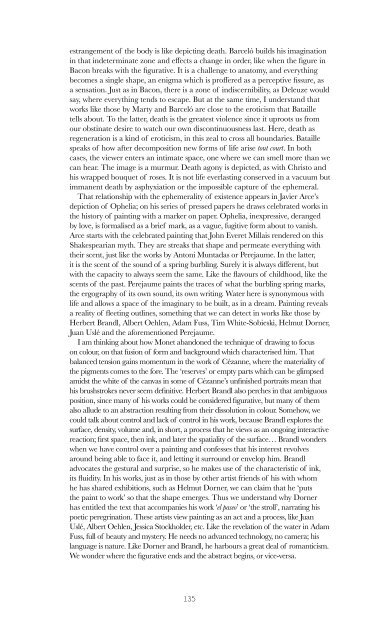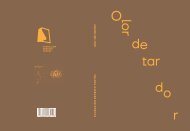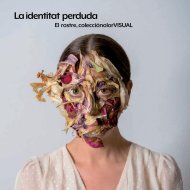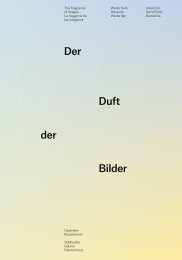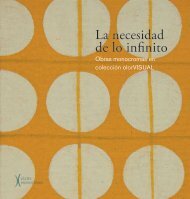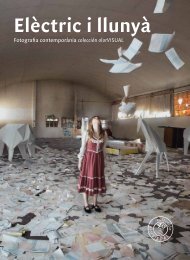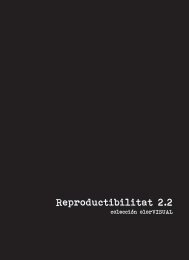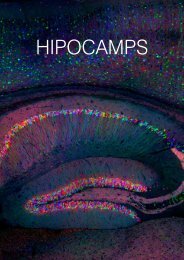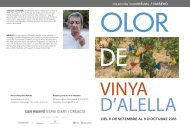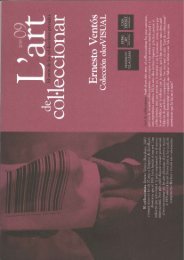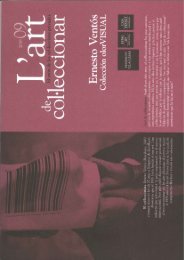You also want an ePaper? Increase the reach of your titles
YUMPU automatically turns print PDFs into web optimized ePapers that Google loves.
estrangement of the body is like depicting death. Barceló builds his imagination<br />
in that indeterminate zone and effects a change in order, like when the figure in<br />
Bacon breaks with the figurative. It is a challenge to anatomy, and everything<br />
becomes a single shape, an enigma which is proffered as a perceptive fissure, as<br />
a sensation. Just as in Bacon, there is a zone of indiscernibility, as Deleuze would<br />
say, where everything tends to escape. But at the same time, I understand that<br />
works like those by Marty and Barceló are close to the eroticism that Bataille<br />
tells about. To the latter, death is the greatest violence since it uproots us from<br />
our obstinate desire to watch our own discontinuousness last. Here, death as<br />
regeneration is a kind of eroticism, in this zeal to cross all boundaries. Bataille<br />
speaks of how after decomposition new forms of life arise tout court. In both<br />
cases, the viewer enters an intimate space, one where we can smell more than we<br />
can hear. The image is a murmur. Death agony is depicted, as with Christo and<br />
his wrapped bouquet of roses. It is not life everlasting conserved in a vacuum but<br />
immanent death by asphyxiation or the impossible capture of the ephemeral.<br />
That relationship with the ephemerality of existence appears in Javier Arce’s<br />
depiction of Ophelia; on his series of pressed papers he draws celebrated works in<br />
the history of painting with a marker on paper. Ophelia, inexpressive, deranged<br />
by love, is formalised as a brief mark, as a vague, fugitive form about to vanish.<br />
Arce starts with the celebrated painting that John Everet Millais rendered on this<br />
Shakespearian myth. They are streaks that shape and permeate everything with<br />
their scent, just like the works by Antoni Muntadas or Perejaume. In the latter,<br />
it is the scent of the sound of a spring burbling. Surely it is always different, but<br />
with the capacity to always seem the same. Like the flavours of childhood, like the<br />
scents of the past. Perejaume paints the traces of what the burbling spring marks,<br />
the ergography of its own sound, its own writing. Water here is synonymous with<br />
life and allows a space of the imaginary to be built, as in a dream. Painting reveals<br />
a reality of fleeting outlines, something that we can detect in works like those by<br />
Herbert Brandl, Albert Oehlen, Adam Fuss, Tim White-Sobieski, Helmut Dorner,<br />
Juan Uslé and the aforementioned Perejaume.<br />
I am thinking about how Monet abandoned the technique of drawing to focus<br />
on colour, on that fusion of form and background which characterised him. That<br />
balanced tension gains momentum in the work of Cézanne, where the materiality of<br />
the pigments comes to the fore. The ‘reserves’ or empty parts which can be glimpsed<br />
amidst the white of the canvas in some of Cézanne’s unfinished portraits mean that<br />
his brushstrokes never seem definitive. Herbert Brandl also perches in that ambiguous<br />
position, since many of his works could be considered figurative, but many of them<br />
also allude to an abstraction resulting from their dissolution in colour. Somehow, we<br />
could talk about control and lack of control in his work, because Brandl explores the<br />
surface, density, volume and, in short, a process that he views as an ongoing interactive<br />
reaction; first space, then ink, and later the spatiality of the surface… Brandl wonders<br />
when we have control over a painting and confesses that his interest revolves<br />
around being able to face it, and letting it surround or envelop him. Brandl<br />
advocates the gestural and surprise, so he makes use of the characteristic of ink,<br />
its fluidity. In his works, just as in those by other artist friends of his with whom<br />
he has shared exhibitions, such as Helmut Dorner, we can claim that he ‘puts<br />
the paint to work’ so that the shape emerges. Thus we understand why Dorner<br />
has entitled the text that accompanies his work ‘el paseo’ or ‘the stroll’, narrating his<br />
poetic peregrination. These artists view painting as an act and a process, like Juan<br />
Uslé, Albert Oehlen, Jessica Stockholder, etc. Like the revelation of the water in Adam<br />
Fuss, full of beauty and mystery. He needs no advanced technology, no camera; his<br />
language is nature. Like Dorner and Brandl, he harbours a great deal of romanticism.<br />
We wonder where the figurative ends and the abstract begins, or vice-versa.<br />
135


